“I honestly finally feel like I can tackle shorebirds, with some level of comfort and confidence. I am so excited to get back out and practice!”
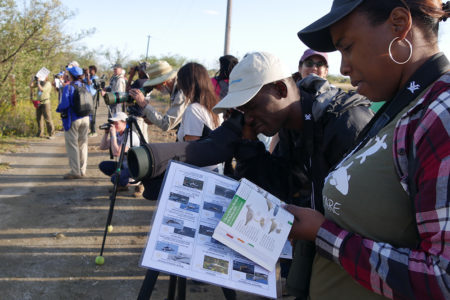
Natalya Lawrence, Coordinator of the Offshore Islands Conservation Programme at Antigua’s Environmental Awareness Group, said this just after she returned from the Conserving Caribbean Shorebirds and Their Habitats International Training Workshop. The event was hosted by BirdsCaribbean in partnership with Manomet and local NGO Sociedad Ornitológica Puertorriqueña (SOPI) at the Cabo Rojo National Wildlife Refuge in Puerto Rico, from February 5 – 11, 2019.
Over five days, 33 enthusiastic participants learned about shorebird identification, monitoring techniques and conservation strategies. They shared ideas, compared experiences, and trekked around watery habitats practicing new field skills. “We were thrilled to work with this enthusiastic group of conservationists this week,” said Lisa Sorenson, Executive Director of BirdsCaribbean. “They have all have pledged to use what they learned to help study and protect threatened shorebirds in their home countries.”
Why Shorebirds?
Shorebirds, like sandpipers and plovers, are among the most threatened groups of birds in the world. Most of them migrate incredible distances every year from high in the Arctic where they breed down to southern South America and back again. Some species, like the Red Knot, will fly over 9,300 miles (15,000 km) — and that’s just one way. Many migratory shorebird species, like Black-bellied Plovers, Greater Yellowlegs, and Semipalmated Sandpipers, rely on Caribbean wetlands to stop and refuel during their long journeys. Some even spend the entire winter! However, shorebird species have been in steady decline since the 1970s. This is due to several factors, all connected with human activities such as loss of habitat from development, disturbance on beaches, and hunting.
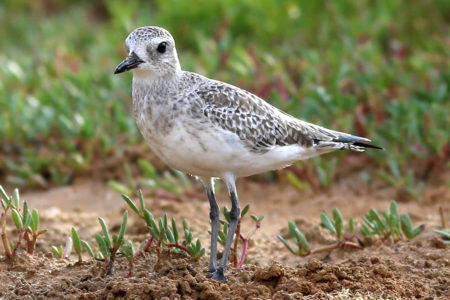
The group of eager Caribbean conservationists at the workshop learned more about these threats, not only direct threats to shorebirds and waterbirds, but also to their habitats: beaches, mudflats, mangroves, and some agricultural areas. They also discussed best practices in monitoring the birds and conducting conservation activities. Importantly, they learned how to take part in two critical monitoring programs, the Caribbean Waterbird Census (CWC) and the International Shorebird Survey (ISS). All of this led to a deeper understanding of the birds’ ecology and conservation.
Another major threat to Caribbean shorebirds is plastic pollution, and the theme of World Migratory Bird Day 2019 reflects this: “Protect Birds: Be the Solution to Plastic Pollution.” With a growing awareness of the harmful impact of plastic across the region on public health and the environment, the group was soon busy with a cleanup at one of the field trip sites, collecting 50 pounds of trash. The exercise was led by Sheylda Diaz Mendez of Environment for the Americas (EFTA) and representatives from the Scuba Dogs Society. This was an excellent hands-on exercise for participants on the management and organization of a cleanup (which is not as easy as it sounds). Plus, the participants had fun, and were delighted to receive cleanup equipment to take back home, thanks to EFTA.
Sharing Experiences Reveals Common Themes
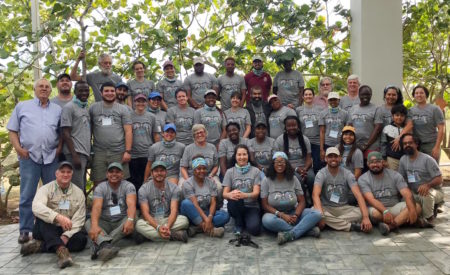
While the first three days focused on basic shorebird and waterbird identification, life history, threats to birds and habitats, and collecting and exploring data, the final two days turned to conservation solutions. After sharing the challenges they face in their countries, it was evident that many islands were experiencing similar issues. Facilitators and trainees then shared ideas and strategies for reducing threats.
In the coming days, participants will have the opportunity to apply for funding from BirdsCaribbean to carry out conservation activities on their islands. The group discussions and brainstorming sessions during the workshop were fantastic opportunities for participants to begin to develop project ideas for this funding. Depending on the threats and priorities at a given site, these projects might include activities such as shorebird and waterbird monitoring, public outreach and education, or a wetland cleanup.
Having people with the same interests and passions from across the region also had other benefits — reminding each other that we are all conserving birds together! “It’s really cool to see how many of us are actually doing this kind of work. Because when you’re on these islands, it’s just you, and you’re like, “The world is on my shoulders! These birds, I’m all they have!” said Shanna Challenger of the Environmental Awareness Group on Antigua. “And it’s really cool to see how many people we have working on the same thing.”
The group of students, wildlife managers and educators from both the government and the non-profit sectors represented 14 island nations: Antigua, the Bahamas, Dominica, Dominican Republic, Grenada, Haiti, Jamaica, Montserrat, Puerto Rico, Saint Lucia, Saint Vincent and the Grenadines, Sint Maarten, Trinidad and Tobago, and the US Virgin Islands.
BirdsCaribbean also benefited from sharing experiences during the week with our partners and co-facilitators for the workshop, Manomet, Inc. Experts in shorebird identification, life history and habitat management, the Manomet team provided enthusiasm and invaluable insights in the classroom and in the field. Their Habitats for Shorebirds Project aligned with the goals of the workshop and BirdsCaribbean is very grateful for all of their help and expertise.
Practice Makes Perfect In the Field
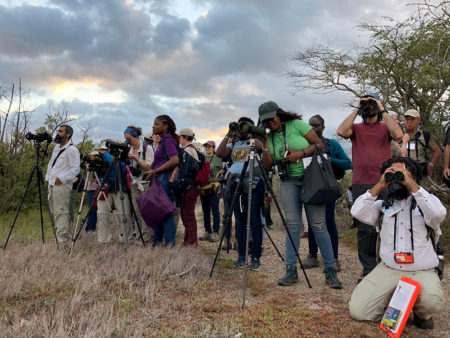
In addition to 30 hours of classroom learning, the group went on six field trips to local wetlands throughout the week. The field trips around Cabo Rojo offered students the opportunity to identify birds in the field and to practice count methods. “The workshop was amazing!” said Zoya Buckmire of the Grenada Fund for Conservation. “We went to a variety of wetland habitats from salt ponds to lakes to beaches. We got to see many different birds and learned some fantastic techniques for identifying and counting them.”
Shorebirds in their non-breeding, or wintering, plumage are notoriously difficult to identify. Sometimes only subtle details harbor the clues. Are the legs black? Are the wingtips longer than the tail? Does the bill droop slightly at the tip?? By the end of the week, the group was becoming more confident in the field marks for tricky birds. The Least Sandpipers at Cabo Rojo Salt Flats were a welcome new species for the group, though many were not convinced of the “yellow” in their yellow-green legs! However, with a week of field trips, it became clear to all that the more you practice, the better you are at field identification.
The workshop ended on a high, with two final field trips to Laguna Cartagena and Salina Fortuna. These were excellent places to practice flock estimation and point counts. While several species of herons and egrets and hundreds of Black-necked Stilts and Glossy Ibis were observed, taking a good look at more secretive species like the Clapper Rail and Sora were a perfect way to end the week. All participants received new Vortex binoculars and ten organizations received a new Vortex spotting scope and tripod – “must-have” equipment for monitoring programs and ensuring proper identification. The group also received field guides and other resources for bird identification and data collection.
Participant Perspectives
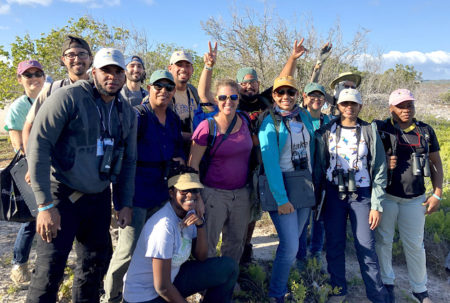
The participants came away with plans to share their newfound knowledge with colleagues. “Thank you so much for always providing opportunities for conservationists in the Caribbean like myself,” wrote Laura Baboolal from Trinidad. She aims to start a shorebird monitoring program for Trinidadian wetlands, and adds: “We hope this can evolve into something greater…Hoping to have some exciting news soon!”
Most Caribbean people live on or near the coast, but have not appreciated or learned much about the birds that inhabit their seashores and wetlands. One of these was participant Reneive Rhoden, from Jamaica’s National Environment and Planning Agency. “I’ve learned so much about shorebirds!” said Reneive. “I grew up on the seaside and I didn’t know anything about shorebirds – and now I know a lot! I can now teach my kids, children in school, and Jamaicans that I work with in my job.”
We are very grateful to the following generous sponsors and partners for contributing to this workshop: Manomet, Inc.; Western Hemisphere Shorebird Reserve Network; Sociedad Ornitológica Puertorriqueña; US Fish and Wildlife Service (Neotropical Migratory Bird Conservation Act Fund); US Forest Service International Programs; Environment Canada; The Cornell Lab of Ornithology; Cabo Rojo National Wildlife Refuge, Para La Naturaleza; Optics for the Tropics, Inc.; Environment for the Americas; Puerto Rico Department of Natural and Environmental Resources, and Vortex Optics.
We invite you to enjoy the gallery of photos below. Hover over each photo to see the caption or click on the first photo to see a slide show.
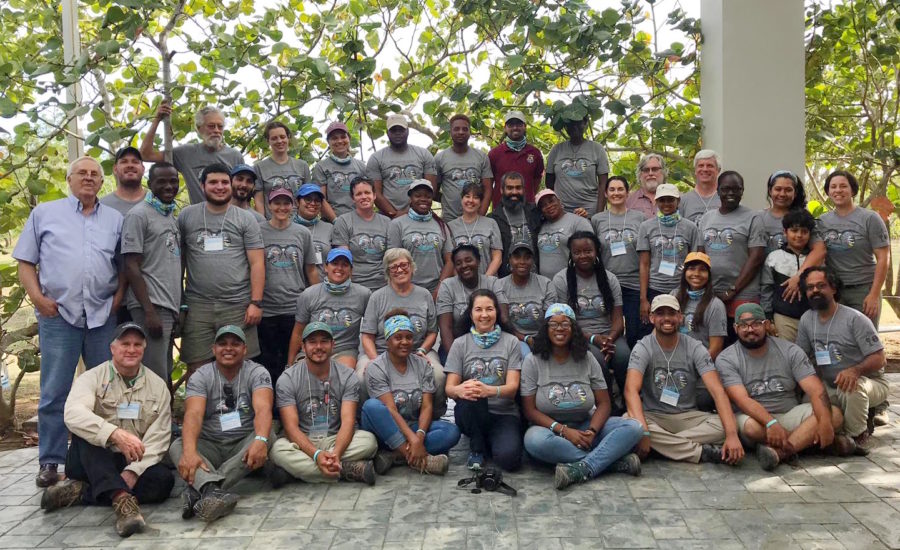

















What a successful workshop! Looking forward to seeing many of these folks in Guadeloupe for our conference – lots of shorebirds to check out down there!
Will there be a next ahorebird workshop this year?
Thanks Justin, it was indeed a fantastic workshop with so many great participants from our network. We hope to see as many of these participants as possible at our Guadeloupe Conference in July 2019!!! Best, Lisa Sorenson
We don’t yet, Shontes, but we hope so! It will all depend on our success with raising the grant funds to have a workshop.